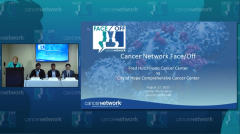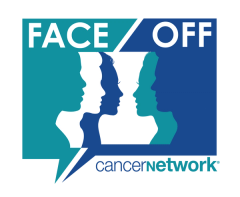
Dosing Strategies and Disease Control With Ponatinib: The OPTIC Study
An expert explores findings of the OPTIC study, revealing optimal dosing strategies for ponatinib in CML treatment, including insights into dose reduction and patient response based on T315I mutation status.
Episodes in this series

Transcript:
Paul B. Koller, MD: The next paper, because these are all…thematically on the same topic, which is why I’m doing 3, is the OPTIC study, which was published in Blood in 2001. The [phase 1] OPTIC trial [NCT03748784] design is…listed here. The patients had to have 2 or more prior TKIs [tyrosine kinase inhibitors]…a T315I mutation, [for] which ponatinib is at the time the only drug that had activity. They had to have reasonable ECOG, and they could not have uncontrolled hypertension, diabetes, or active cardiovascular disease. They were [randomly assigned] in a 1:1:1 manner for the 3 doses we have for ponatinib, which are starting at 45 mg, starting at 30 mg, and starting at 15 mg a day. And then I think interestingly, and this…has mimicked…what we’ve done a lot in practice, was a dose reduction when the disease control got quite good, to 15 mg, when the PCR [pathologic complete response] got to less than 1%.
And so here are the baseline characteristics of the study.… It…skews younger than the average CML [chronic myeloid leukemia] patient, but not protocol. Most protocols are younger patients. And…the risk factors are noted. The weight is overweight from a BMI [body mass index] standpoint. And there are plenty of T315I mutations in this cohort. About a quarter of the patients had it. And the reason the prior therapy was stopped was for resistance the vast majority of the time, and not intolerance, which is key. It’s much easier to treat people with intolerance than it is with resistance, at least to show responses.
Here is the response by dose and the median dose intensity. It’s very interesting that the higher the dose, the better response you got. And…the responses were faster and deeper with the 45 mg cohort versus the 30 mg and the 15 mg cohort. You look at 45 mg in red, 30 mg in blue and 15 mg in green, and it’s like a nice stepladder. The median dose intensity is in that…table at the bottom showing that by 6 months, the 45 mg dose had…almost caught up to the 30 mg dose by intensity. And then by 12 months, the median dose of the 45 mg cohort was the same as the 15 mg cohort. Adverse events [AEs] were higher in the 45 mg cohort than the 30 mg cohort than the 15 mg cohort.
So there is a…a risk benefit analysis here. And there was a…correlation between AEs and response. This is…a balance nicely shown here. The key takeaways…from this study, at least for me, is that unless you have a reason not to, patients on ponatinib should be started on 45 mg and dose reduced to 15 mg when the PCR is less than 1%. And it led to a reduction in AEs with pretty excellent disease control in this population.
And so, to complete the 3 articles, abstracts, etc, this is a post hoc analysis of responses by T315I mutation status in the 3-year update of the OPTIC trial. There [are] some nice takeaways here. Basically…this is all I had, was a table. This was presented at EHA [the European Hematology Association Congress]…last year. I think it’s interesting to note, and this is one of the things I was most interested in, that patients with T315I mutations who had their dose de-escalated…and lost their response were able to re-escalate and re-achieve their BCR-ABL of less than 1% in the T315I mutation and in the no-mutation cohorts. Actually, in the no-mutation cohort, the number of people who lost their response was very low.
So it would be reasonable to potentially watch…patients with the T315I mutation a little closer to make sure that they don’t lose their response, but that they can be resalvaged if needed. This is…a summary slide, which is general risk factors of AEs increase the risk of these events when on ponatinib. And…a new dynamic optimal dosing of ponatinib can reduce these events in patients on ponatinib, which is 45 mg down to 15 mg when the PCR hits less than 1%. And then patients who have a dose reduction and then lose their response can be salvaged with re-escalation of that dose. And Dr Oehler is going to talk about whether they can be switched to newer therapies, which is nice that we have.
Transcript is AI-generated and edited for clarity and readability.
Newsletter
Stay up to date on recent advances in the multidisciplinary approach to cancer.



















































































